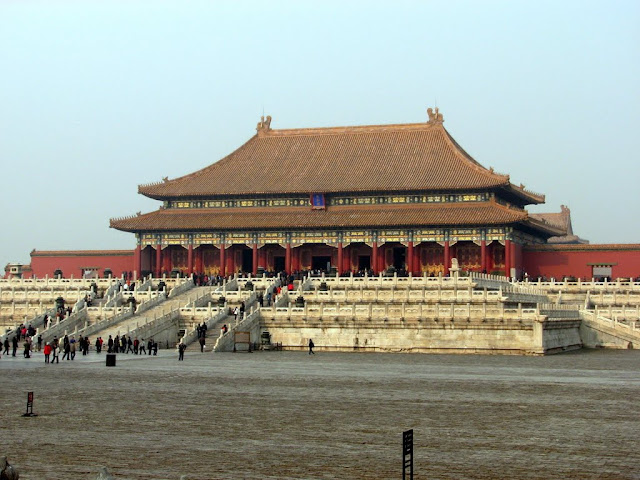Wednesday, 17 November
This was my biggest walking day yet, because I was now on my own. The destination was UNESCO World Heritage Site number four: finally, the Forbidden City. I did the half-hour walk to the subway (National Library station), and took it to the Xidan station, getting close and avoiding a line change (I could have changed to line 1 and taken it one stop to Tian’anmen West, but that seemed excessive when I could just walk). 
Tian’anmen (天安门, Heaven Peace Gate) is the south gate to the Forbidden City, and Tian’anmen Square is a large, open, public plaza across the busy street from Tian’anmen. The square is largely featureless, except for an unimposing monument to China’s heroes and, now, two large, wide, rectangular video screens that show attractive images in a cycle.
The Forbidden City (紫禁城), also referred to as the former palace (故宫), now houses the Palace Museum. I spent some four and a half hours there, checking out as many buildings as I could, and, as advice went, not missing the exhibits in the side buildings.

gates
, and a magnificent garden. It was the palace for the Ming (大明) and Qing (大清) dynasties — the last two of the Chinese imperial dynasties — from the early 15th century into the first years of the 20th century. There’s been extensive restoration, to show it as it was during the times of the emperors.
When I was done, I went out the north gate, the Gate of Divine Prowess (神武门), and under that street to Jingshan (景山) Park, where I’d been on Friday night. I spent a while in the park, including climbing to the top of the hill again, and then walked up to Di’anmen Avenue (地安门, Earth Peace Gate), wandered a little in Hou Hai (it was too early for the bars to be hopping, but that didn’t stop at least 17 people from haranguing me to ride in their rickshaws), then continued on Di’anmen Street to the Ping’anli subway station. Back to the start, a half-hour walk back to the hotel, and a little farther to the Food Cube (with an interestingly mathematical logo: 103, where I ordered some tasty noodles with minced meat, cabbage, onions, and mustard seeds. And a beer. The beer went down very nicely after all the walking.
I prefer having people to tour with, but the nice things about being on my own are that I can walk all I want to (about seven hours today, though much of that was strolling in the Forbidden City and its galleries), and I can make it a two-meal day. The breakfast buffet in the hotel is huge and can easily fuel the day, and I can have a lighter dinner, as I did today, after the touring.
The smog was much worse today than on previous days. Saturday, at the Great Wall, was quite clear (it was also outside the city). Sunday was hazy but still blue and nice. But by now the haze mostly blocked out the sun, and it’s apparent in many of the photos (I’ve picked ones here where it’s not so obvious).
One thing about the tourist spots in Beijing, though, is that they’re mostly related to the emperors, and mostly built during the Ming and Qing dynasties. So they’re mostly built by emperors with the same preferences. They have the idea that certain things are auspicious
, and so there are dragons and cranes and tortoises (longevity) everywhere, the buildings are all of the same design and use the same colours, and so on. The result is that there’s not really much of a difference — Summer Palace, Temple of Heaven, Forbidden City — there’s a real sameness throughout them all. I didn’t feel like I was going to several different places, but to some extent spending multiple days walking around in the same one.
It’s still very cool, though, all the same.






No comments:
Post a Comment